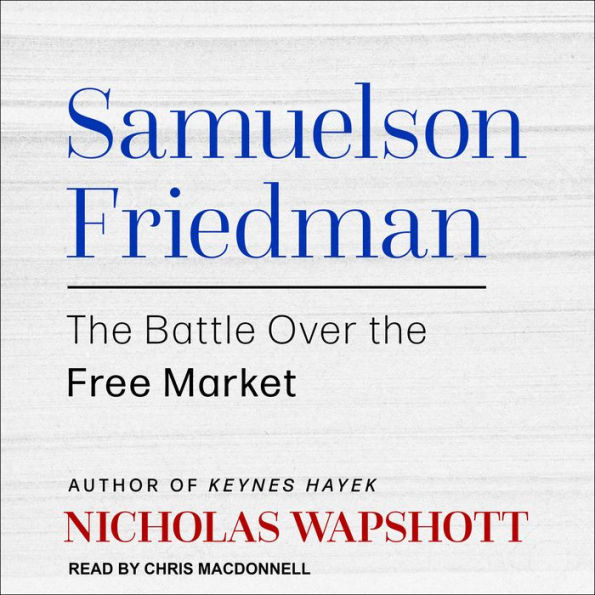Publishers Weekly
04/26/2021
Journalist Wapshott (Keynes Hayek) returns with another lucid and character-driven account of the rivalry between two leading economists. From 1966 to 1981, MIT professor Paul Samuelson, author of a popular Keynesian economics textbook, and Milton Friedman, a leader of the conservative Chicago school of economics, debated their differences of opinion in a series of alternating columns for Newsweek. Wapshott details the “generosity and civility” Samuelson and Friedman showed each other, and chronicles the waning of Keynesian economics as the U.S. confronted “stagflation” (high inflation coupled with stagnant economic growth) in the 1970s. Friedman was a “street fighter” eager to see his monetarist theories put into practice, while the more moderate Samuelson attempted to synthesize Keynesian economics and the free market principles of the Chicago school. Both men won the Nobel prize, but Wapshott contends that the Great Recession primarily vindicated Samuelson and “shook the commonly held belief that free-market forces, left to their own devices, would act to ensure the perpetual prosperity, full employment, and growth that Americans demanded.” Wapshott briskly explains the underlying economic theories and enlivens his account with cultural history and colorful character sketches. The result is an accessible and nuanced introduction to two of the most influential economists of the 20th century. (June)
Two Economists Go to War - Literary Review - Zareer Masani
"Summarising the debate between the two most important economists of the second half of the 20th century may seem like a monumental task, best consigned to specialist textbooks. But this brave history of the intellectual dual between Paul Samuelson and Milton Friedman proves that assumption wrong, with its focus as much on their lives as on their ideas."
Samuelson and Friedman — a rivalry that echoes down to the present - Financial Times - Adam Tooze
"If you had to name the two most influential economists of the postwar decades, you would not go far wrong if you picked Paul Samuelson and Milton Friedman… As Wapshott shows, their arguments over the proper scope of government intervention and the control of inflation echo down to the present."
Best Books of 2021: Economics - Financial Times - Martin Wolf
"This is a follow-up to the author’s Keynes Hayek. Its focus is with the debate between MIT’s Paul Samuelson and Chicago’s MiltonFriedman, whose contrasting views graced the pages of Newsweek for 18 years. Samuelson was an economist’s economist: his methodological influence was profound. Friedman had a huge influence on monetary economics. But his political influence was arguably even greater. By focusing on these two men, Wapshott illuminates debates that remain current to this day."
Kirkus Reviews
2021-05-12
Broad-ranging dual biography of two diametrically opposed economists and their influence on current theory.
The author of a previous pairing of the intellectual forebears of his present subjects—John Maynard Keynes and Friedrich Hayek—Wapshott recounts the rise to prominence of Paul Samuelson (1915-2009) and his ideological counterpart, Milton Friedman (1912-2006). Both grew up under similar circumstances, the worldly children of Jewish immigrants, and both arrived at a nearly opposite view of economics, particularly as an instrument of politics. The two were well aware of each other when Newsweek hired both to write an alternating column on economics. Samuelson originally declined, having earned a substantial income from his textbook on economics, which remained a standard into the 1970s. Finally, he relented after being paid the modern equivalent of $98,600 for a mere 17 pieces. “Finding an articulate, young economist who would counter Samuelson’s viewpoint would not be easy,” writes Wapshott, but finally Newsweek brought Friedman on board. By then, Friedman had already laid out the bare bones of modern libertarianism, which holds that the free market regulates itself and government has little if any role in it, or indeed in daily life. Samuelson, meanwhile, was an exponent of the quantitative easing and other interventions that Keynes had brought to bear on the Depression. The two remained grudgingly admiring rivals for five decades. Though Samuelson considered Keynes the greatest economist in history, alongside Adam Smith and Léon Walras, Friedman remained convinced that “all attempts to temper the market, however well intended…were doomed because they hampered the efficient operation of capitalism, which, when left to its own devices, was sure to maximize the benefits to society.” Though Friedman’s libertarianism remains influential, particularly among conservatives, it is not unalloyed: He favored legalizing drugs and diminishing the military, for instance. Samuelson’s view was tested and found largely correct, though, with the Great Recession of 2008, when, as a British newspaper put it, “it was Samuelson’s prescriptions, rather than Friedman’s, that carried the day.”
Students of the dismal science will enjoy this well-written account of a clash of titans.



